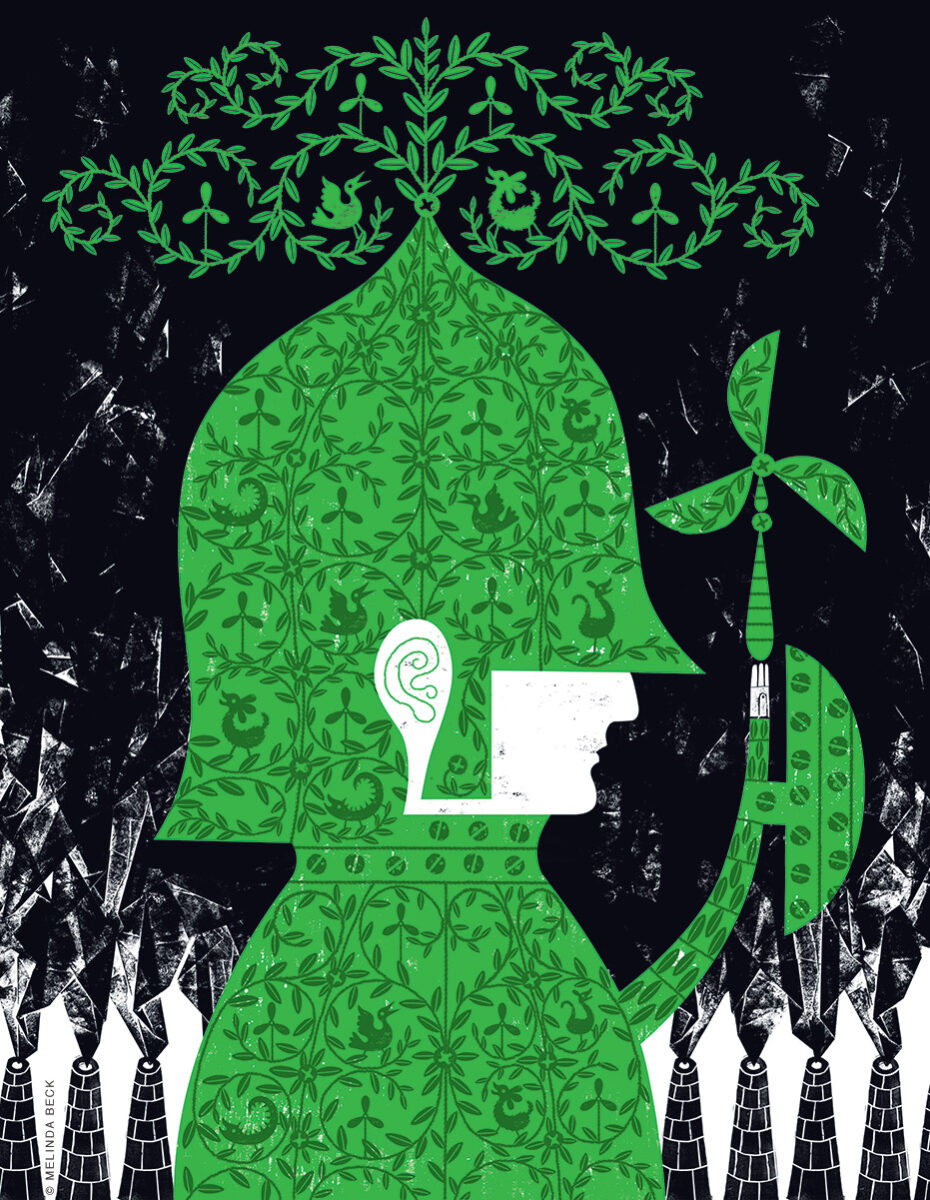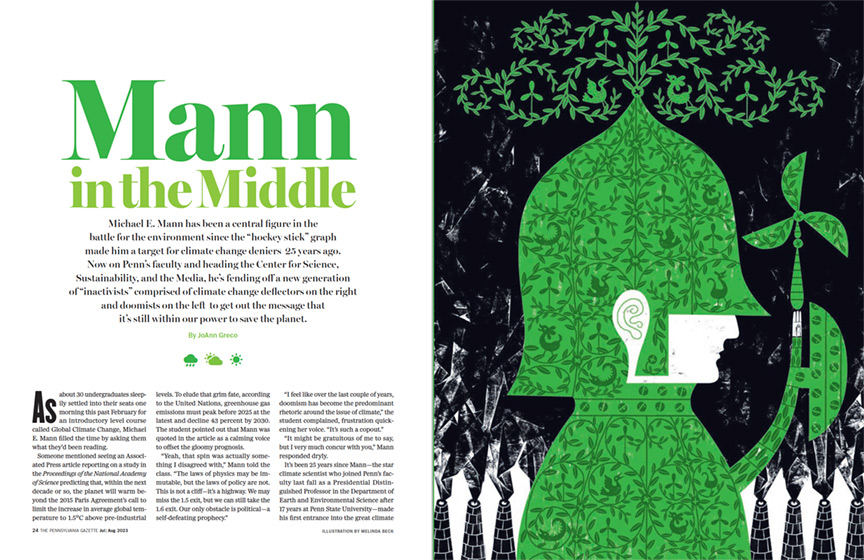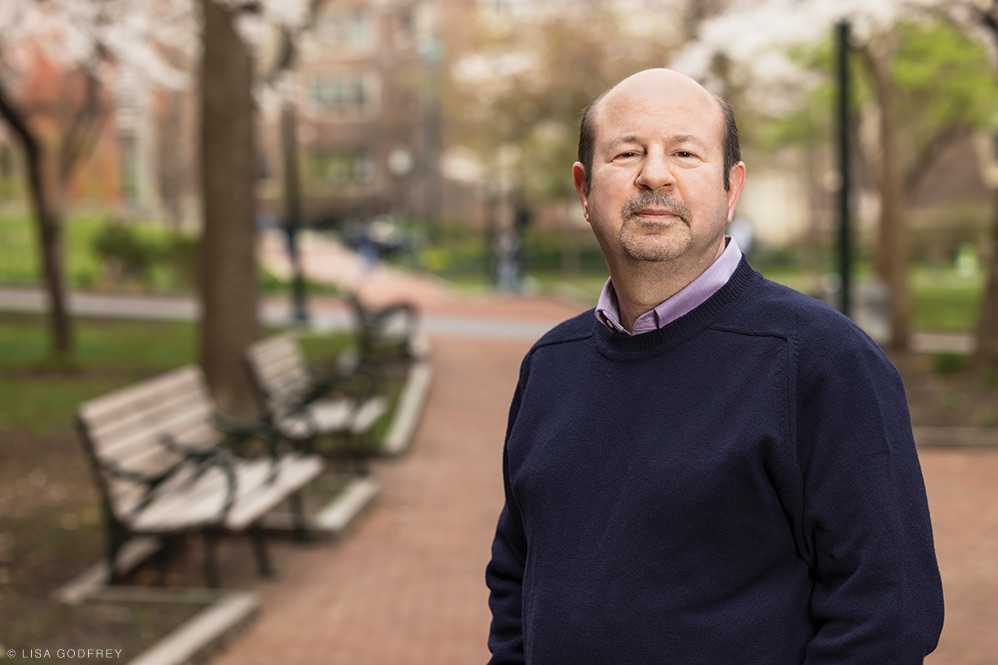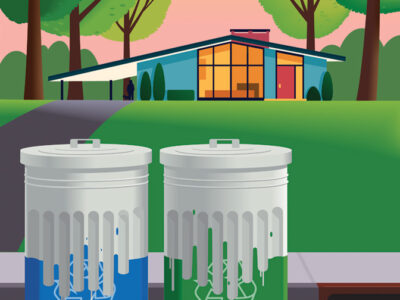
Michael E. Mann has been a central figure in the battle for the environment since the “hockey stick” graph made him a target for climate change deniers 25 years ago. Now on Penn’s faculty and heading the Center for Science, Sustainability, and the Media, he’s fending off a new generation of “inactivists” comprised of climate change deflectors on the right and doomists on the left to get out the message that it’s still within our power to save the planet.
By JoAnn Greco | Illustration by Melinda Beck

As about 30 undergraduates sleepily settled into their seats one morning this past February for an introductory level course called Global Climate Change, Michael E. Mann filled the time by asking them what they’d been reading.
Someone mentioned seeing an Associated Press article reporting on a study in the Proceedings of the National Academy of Science predicting that, within the next decade or so, the planet will warm beyond the 2015 Paris Agreement’s call to limit the increase in average global temperature to 1.5°C above pre-industrial levels. To elude that grim fate, according to the United Nations, greenhouse gas emissions must peak before 2025 at the latest and decline 43 percent by 2030. The student pointed out that Mann was quoted in the article as a calming voice to offset the gloomy prognosis.
“Yeah, that spin was actually something I disagreed with,” Mann told the class. “The laws of physics may be immutable, but the laws of policy are not. This is not a cliff—it’s a highway. We may miss the 1.5 exit, but we can still take the 1.6 exit. Our only obstacle is political—a self-defeating prophecy.”
“I feel like over the last couple of years, doomism has become the predominant rhetoric around the issue of climate,” the student complained, frustration quickening her voice. “It’s such a copout.”
“It might be gratuitous of me to say, but I very much concur with you,” Mann responded dryly.
It’s been 25 years since Mann—the star climate scientist who joined Penn’s faculty last fall as a Presidential Distinguished Professor in the Department of Earth and Environmental Science after 17 years at Penn State University—made his first entrance into the great climate change debate after coauthoring a paper that introduced the immediately iconic and enduringly controversial “hockey stick” graph.
So dubbed for its mostly flat and then steeply ascending shape, the graph neatly distilled complex and disparate data to illustrate, simply and clearly, the dramatic uptick in world temperatures during the late 20th century. From the start, climate deniers questioned Mann and his colleagues’ methods and conclusions, and things grew ever nastier over the years.
Mann emerged from the flurry of attacks intent on pursuing his science but also determined to fight climate change deniers in the public arena. Looking back, he offers a summary of the decades-long brawl: “I was subject to attacks on my ideas, my integrity, my livelihood, and my life,” he says. “I do feel privileged, though, to be in the position of being an important voice in the greatest challenge we’ve ever faced. None of that would have happened if not for the hockey stick.”
Drew Shindell, an earth sciences professor at Duke University who’s known Mann for 20 years, observes that “rather than retreating into a shell and not engaging, Mike has used those attacks and made them part of his very compelling personal narrative.”
There’s been no shortage of accolades to balance the attacks. Along with fistfuls of awards and citations from a variety of professional associations, Mann has been rated as among the 50 leading visionaries in science and technology by Scientific American, and his work was cited as contributing to the 2007 Nobel Peace Prize jointly awarded to the Intergovernmental Panel on Climate Change (IPCC) and Al Gore. Just months ago, he was named the 2023 Humanist of the Year by the American Humanist Association.

In the classroom, he’s a nonintimidating, genial presence, offering patient tutelage and spot-on metaphors delivered with Wallace Shawn-like intonations and quizzical sidelong glances. His commitment as an educator is one of Mann’s “best qualities,” says his friend Bill Nye (aka “the Science Guy”). “He’s someone who is playing at the very top of his game, and here he is teaching classes to undergraduates. He wants them to get excited about their ability to do something about the climate crisis.”
That’s certainly the case for Jasper MacLean C’23, an environmental science major who, though he found the class itself “a bit elementary,” adds that he “really wanted to take it because I like exploring the policy and philosophy behind educating people in these issues. Most professors don’t go into that.”
Mann’s current scientific research includes studies on factors affecting the beginning and end of ice ages, which have implications for predicting the behavior of melting ice sheets in the present day, and on the connections between climate change and extreme weather. With a secondary appointment in the Annenberg School for Communication, he also has a platform to combat the forces of denial and spread accurate information on climate change as director of the new Center for Science, Sustainability, and the Media.
“Michael Mann is not only a distinguished scientist but a highly visible and accessible communicator of science,” says Kathleen Hall Jamieson, the Elizabeth Ware Packard Professor of Communication and director of the Annenberg Public Policy Center. “He is very interested in the ways in which media shape our understanding of climate science.”
Mann has been a source for the APPC’s factcheck.org for decades, Jamieson adds. “As Penn was trying to recruit him, I met with Michael and told him we were standing ready to do anything that we could to help him join us.” Next year, she notes, the annual meeting of the Society of Environmental Journalists will be held at Penn “as one of the first major activities to tell the world that Michael Mann is here.” In the meantime, the Center has presented several interdisciplinary panels, including an introduction to the business and investment approach known as ESG (for Environmental, Social, and Governance) that takes nonfinancial factors into account, cosponsored with the Kleinman Center for Energy Policy and the Wharton Climate Center. Last fall, Jamieson moderated a panel discussion at Perry World House with Mann and Malcolm Turnbull, who advocated for sustainable energy and climate action policies as prime minister of Australia [“Gazetteer,” Nov|Dec 2022].
The Center “will host events to bring together policy and business leaders, researchers, students, and faculty,” Mann says. “We want to propel Penn to the very forefront of the climate conversation today. It’s exciting for me to be here at this time.”
Mann’s latest book, The New Climate War (PublicAffairs, 2021), gives a good sense of how he views the current state of battle. In it, he takes on the fossil fuel industry, internet trolls, and bad actors in government and media, who he says conspire to deflect attention from the problem—since outright denial of the physical evidence of climate change is no longer credible.
This “new climate war” adopts the playbook of deflection campaigns mounted by the tobacco industry and the gun lobby. An early example of the genre in the environmental area was the “crying Indian” anti-littering public service announcement of 1971, released under the auspices of an organization called Keep America Beautiful. Beyond the deception of using a buckskin-adorned Italian American actor with a talent for tearing up as the star, a consortium of beverage companies was behind the ads, with the goal of stopping the passage of bottle bills that would be costly and burdensome for them to implement and manage. The idea in all cases: we as individuals need to step up and take responsibility, absolving corporations from taking a role.
Similarly, climate “inactivists,” as Mann calls them, tout personal actions—recycle, become a vegetarian, stop flying—as the primary solution to the climate crisis. “Though these actions are worth taking,” Mann writes, “a fixation on voluntary action alone takes the pressure off of the push for governmental policies to hold [companies like ExxonMobil, Shell, and BP] accountable.”
Emphasis on the individual’s responsibility is also handy in attempts to divide and conquer, such as by pitting climate scientists and environmentalist factions against each other over how much their “personal carbon footprint” (a concept that BP was an early promoter of in the mid-2000s, Mann says) undermines their authority as advocates for policy change. In one passage, he details a cooked-up controversy in which he was accused of indirectly attacking the young Swedish activist Greta Thunberg (for actions like sailing rather than flying across the Atlantic for a UN climate summit)—during an interview where he criticized inactivists for deflecting attention from systemic solutions to personal action. He also recounts stories of other climate scientists, as well as celebrity advocates like Leonardo DiCaprio and Al Gore, who have been charged with hypocrisy for their excessive consumption of, say, meat, energy, or jet fuel.
Climate change deniers turned deflectors have also worked to thwart economic measures like cap and trade, a carbon tax, or carbon credits designed to level the playing field between fossil fuels and renewables—aided at times, to Mann’s regret, by climate advocates on the left; fan fears that climate action will destroy jobs; and paint renewable energy projects as unreliable because the sun isn’t always shining or the wind blowing.
Another technique involves advocating for “non-solution solutions” like large-scale carbon capture and sequestration or using geoengineering, say, to control the climate—a favorite of former Microsoft CEO, philanthropist, and tech visionary Bill Gates, who Mann notes has spent millions supporting research on the concept. For various reasons, Mann argues, all of these technologies will be ineffective and/or dangerous—and are unnecessary. A truly viable path forward “involves a combination of energy efficiency, electrification, and decarbonization of the grid through an array of complementary renewable energy sources,” he writes. “The problem is that fossil fuel interests lose out in that scenario, and so they have used their immense wealth and influence to … deflect attention from these real climate solutions, promoting in their place ostensible alternatives.”
Mann frequently uses the phrase “urgency and agency” to characterize his own perspective, emphasizing both the enormous stakes involved in climate change and the conviction that acting quickly and forcefully to implement policies to combat it can have an impact. A significant chunk of the book addresses commentators—many of them ostensible allies—who dismiss the second part of that mantra. In a chapter titled “The Truth Is Bad Enough,” he takes on climate activists who display “a distinct appetite for all-out doomism—portraying climate change not just as a threat that requires urgent response, but as an essentially lost cause, a hopeless fight.”
Citing both fringe outlets and high-profile examples like the novelist Jonathan Franzen’s New Yorker article, “What If We Stopped Pretending? The Climate Apocalypse Is Coming. To Prepare for It, We Need to Admit We Can’t Prevent It,” and journalist David Wallace-Wells’ New York Magazine article and later book The Uninhabitable Earth, Mann argues that their claims about runaway temperatures and cascading effects leading to a hellish future landscape have little basis in climate science (which has actually done a pretty good job of predicting impacts so far) and also reinforce more general doubt and distrust of that science—playing into the hands of climate deflectors/deniers. Such “climate doom porn” may now be “a greater threat to climate action than outright denial,” he suggests.
As an alternative, Mann offers his own four-point battle plan for the new climate war: Disregard the doomsayers. (“The climate crisis is very real. But it is not unsolvable. And it’s not too late to act,” he writes. “Every ounce of carbon we don’t burn makes things better.”) Take to heart the example of young people like real-life activist Thunberg and the fictional Sophia, protagonist of a children’s book Mann coauthored, The Tantrum That Saved the World. (“The children speak with a moral clarity that is undeniable to all but the most jaded and cynical. It is a game-changer.”) Don’t allow climate denialists to pose as good faith “skeptics” and focus on educating “those who are reachable, teachable, and movable.” Finally, while acknowledging the value of individual action, concentrate on systemic changes aimed toward decarbonizing the energy sector. On this last point, the coronavirus offered a telling lesson “about the limits of behavior change alone,” when widespread lockdowns only cut global emissions by 4 percent.
Mann grew up in Amherst, where his father was a math professor at the University of Massachusetts. He took to math and science early—he remembers stopping by Penn to pay homage to ENIAC while on a family visit to Philadelphia—but mostly as the path of least resistance, rather than out of a passion for the subjects.
That changed when he encountered the work of charismatic scientist, author, and television personality Carl Sagan, whose PBS program Cosmos premiered when he was a high school freshman. “Sagan showed me the magic of scientific inquiry,” he writes, and “made me realize it was possible to spend a lifetime satisfying one’s scientific curiosity by posing and answering fundamental existential questions.” Later in the 1980s, Sagan became an ardent opponent of the Reagan-era Strategic Defense Initiative and was subjected to the kind of personal harassment and professional discrediting that Mann himself would later contend with. In another common thread, Sagan’s controversial nuclear winter simulations “were based on early-generation global climate models.”
By that time, Mann had made his way from Amherst to college at UC-Berkeley, where he double majored in applied math and physics. He then moved on to Yale for master’s degrees in physics and a PhD in geology and geophysics. In his second year in New Haven, he found himself idly thumbing through a course catalog looking for a change of pace. He noticed a class offered by Barry Saltzman, a giant in the field of weather and climate. For a physics and math guy like Mann, though, what was really intriguing was the fact that Saltzman’s work during the early 1960s had become the acknowledged progenitor to chaos theory as developed by fellow meteorologist Edward Lorenz, which seeks to define the patterns underlying seemingly random events. Math and physics and climate—it was the beginning of a beautiful friendship. Mann became interested in studying the natural variability of climate and wound up with Saltzman as his PhD advisor.
An encounter at a wine tasting between Mann’s father and Raymond S. Bradley, head of the department of geosciences at UMass Amherst, proved fortuitous. When Lawrence Mann told the geography professor of his son’s studies at Yale, Bradley invited the younger Mann to come back home to Amherst for his postdoc. “The funny thing,” recalls Mann, “is that Ray’s son was my 10th grade lab partner in biology!”
Mann was soon ensconced in an upstairs apartment in his parents’ house and ready to work with Bradley and Malcolm K. Hughes, a University of Arizona specialist in interpreting proxy climate indicators (as opposed to actual temperature recordings) like tree rings, ice cores, and coral. Their resulting paper, with Mann as lead author, analyzed climate data back to the year 1400 and was published in Nature on Earth Day 1998, a year that would turn out to be the warmest one since modern climate records had begun 150 years earlier. The study was picked up by major dailies, newsweeklies, magazines like Rolling Stone, and national broadcasts.
The attention led to another pleasant surprise for Mann—his selection as a lead author for the then-forthcoming IPCC Third Assessment Report (to be published in 2001). In early 1999, Mann and colleagues also released a follow-up to the 1998 paper that incorporated data going back to 1000.
Gavin A. Schmidt, now director of the NASA Goddard Institute for Space Studies, remembers those days well. “I was at McGill University working in a group that was focused on climate and this was a new thing at the time,” he says. “Climate was studied by atmospheric scientists, oceanographers, paleontologists, and Michael and I came from physics and math, so our trajectories kind of reflected that. We were trying to work out how we could make a mark.”
Mann’s work, beyond its importance to climate science, was “sociologically interesting” because of those silos. While analyses of paleoclimate had been going on since before the ice age cycles were discovered in the 1960s, “the way of working in that field was for many individual people to focus on many individual sites going back in time,” Schmidt says. “There wasn’t a culture of synthesis. Mike is coming from outside of the field, and he’s coming in with this notion of, ‘What can I do, using my math and my stats?’ and then Ray is like, ‘Why don’t we put it all together?’ And that’s the genesis of the hockey stick,” he recalls.
“Initially it was like, this is great …. We would hang out and Mike was basking in the attention, being invited to give keynotes—it was a big step up for him professionally,” Schmidt adds. “Then we started to see the bad faith attacks because it became so high profile.” While the specifics varied, they all boiled down to Mann “getting blamed for the fact that it’s obviously warming up over the 20th century, and to a lot of people who would rather that that not be true—including the fossil fuel industry—he became the fall guy.”
Attempts to undermine the hockey stick began in the late 1990s and conservative media outlets and politicians continued raising questions for years. In 2006, the National Academy of Sciences even felt compelled to put out a statement that the conclusion of Mann and his colleagues “has subsequently been supported by an array of evidence that includes both additional large-scale surface temperature reconstructions and pronounced changes in a variety of local proxy indicators, such as melting on ice caps and the retreat of glaciers around the world.”
In 2009, emails written by Mann and other climate scientists were hacked in an effort to discredit them, an occurrence inevitably dubbed Climategate. Later that year, factcheck.org presented an analysis of the claims. “The 1,000-plus e-mails sometimes illustrate the hairier side of scientific research,” it read in part. “Criticisms of climate change are sometimes dismissed as ‘fraud’ or ‘pure crap’ …. Other messages, like a 2007 e-mail from Michael Mann of Penn State University, show indignation at being the target of skeptics’ ire …. Claims that the e-mails are evidence of fraud or deceit, however, misrepresent what they actually say.”
Nevertheless, Virginia’s Republican attorney general, Ken Cuccinelli II, launched a two-year investigation of Mann, looking for evidence of fraud during his time as a researcher and professor at the University of Virginia. And in 2012, a blog post on the website of the Competitive Enterprise Institute (whose self-described mission is to “reform America’s unaccountable regulatory state”) compared Mann to disgraced Penn State football coach Jerry Sandusky, “except that instead of molesting children, he has molested and tortured data”—a comment that was repeated by outlets including the National Review and Wall Street Journal.
“It really never stopped,” Mann says.
“I would have been very happy staying in the background doing the science that I love doing,” he adds. “But they engaged me, to attack and vilify and intimidate me in a cynical effort to discredit my work. I’ve personally seen the enemy close up for decades—I see how they operate and the tactics they use. It took a toll, for sure.”
The resulting atmosphere of controversy, Mann believes, made funding agencies shy away from supporting him. “Personally, I received the nastiest emails you can imagine; there were death threats aimed at me and my family. I received an envelope containing white powder.”
Eventually Mann and his peers learned how to fight back.
“We ended up going to workshops on journalism and media,” Schmidt says. “We learned how to tell a story, how to get down to what’s important for people to understand, how to combat bad information. How to get the scientist back into the discussions.”
One of the people Mann turned to was Susan Joy Hassol, a science writer and consultant who directs Climate Communication, a nonprofit that helps climate scientists learn how to get their message across to the general public simply and without jargon. Mann is listed as a science advisor to the organization.
“Mike has learned how to get his wonderful sense of humor through in his writing and to use metaphor and turns of phrase like the ‘urgency and agency,’ which came naturally out of his brain and is just perfect,” Hassol says. Some 20 years after they first met, the two still regularly team up to write op-eds around teachable moments like extreme weather events—see, for example, “The Heat Dome? Yeah, It’s Climate Change,” in the New York Times in June 2021, and “Enjoy the Weather. Worry About the Climate” in the Hill, last February.
Along with Bradley, Schmidt, and a few others, Mann also launched realclimate.org in 2004, when the notion of direct peer-to-peer communication via blogging was new. “The trigger was the movie The Day After Tomorrow,” Schmidt says with a laugh. Premised on a sudden climate shift that triggers a new ice age, the film had, he quips, the “distinction of being the best movie that has a paleoclimatologist as a hero and the worst movie that has a paleoclimatologist as a hero.” Still, with headlines like “Some new CMIP6 MSU comparisons,” the site is a pretty wonky and insidery effort.
“We in the scientific community produce things like giant IPCC assessments,” says Shindell, who has also contributed to the blog. “But basically the story remains the same—you have to stop using fossil fuels or you’re going to wreck the planet—which is what it was decades ago.
“Communicating the societal impacts of climate change and of different mitigation options, I think, makes the discussion more palatable,” he adds. “If you can say, these many fewer people will die from heat waves, the number of children’s asthma hospitalizations will decrease by this much, this many more people will be employed in new energy industries …”
When it comes to putting the crisis into a relatable context, Mann for one “leaves no stone unturned,” Hassol says.
Each of Mann’s books have tackled the warming problem in a different way. Published in 2008, Dire Predictions: Understanding Climate Change, written with Penn State Professor of Geosciences Lee R. Kump, is a graphics-intense layperson’s introduction to the nearly two decades worth of lengthy IPCC reports. Four years later, Mann’s second book, the memoirish The Hockey Stick and the Climate Wars, delved into the science behind that graph, the resulting controversy, and Climategate. Four years after that, Madhouse Effect, created with coauthor, Tom Toles, a Pulitzer Prize–winning editorial cartoonist for the Washington Post, offered a one-two punch of clever language and witty drawings to debunk climate deniers.
Mann contributed scientific background and explanatory text suitable for young children for The Tantrum That Saved the World, by writer and illustrator Megan Herbert, in which the teenaged Sophia one day finds a parade of displaced animal, insect, and then human refugees arriving at her doorstep and vows to help them by marching, with protest sign aloft, to City Hall, where she is joined by her young friends. The book ends with Sophia standing on the steps of the White House. Originally self-published by Herbert in 2017, Tantrum came out a year before the then-15-year-old Thunberg began organizing her “Fridays for Future” campaign, leading thousands of students to skip school each week to protest for more action against climate change.
Following last year’s New Climate War will be Our Fragile Moment: How Lessons from Earth’s Past Can Help Us Survive the Climate Crisis, scheduled for publication this fall. “Climate variability has at times created new niches that humans or their ancestors could potentially exploit, and challenges that at times have spurred innovation,” reads the book’s advance notice.
In considering the opportunities and challenges of climate swerves—and the potential disaster when things get too far off course—it’s impossible not to think of COVID-19 and the crisis the world has recently endured. “The novel pandemic, in terms of forcing animals out of their natural habitats and into contact with human populations was, like climate change, a consequence of our destruction of our earth,” Mann observes. “It also drove home that anti-science is deadly: the defiance of public health messaging, refusal to get vaccinated and to wear masks, that became part of a tribal identity. It was right out of a dystopian nightmare.
“My childhood hero, Carl Sagan, basically presages all of this,” he continues. “I quote a passage from him in The New Climate War, and I tweet it often. It’s from The Demon-Haunted World.” The segment reads:
I have a foreboding of an America in my children’s or grandchildren’s time—when the United States is a service and information economy; when nearly all the manufacturing industries have slipped away to other countries; when awesome technological powers are in the hands of a very few, and no one representing the public interest can even grasp the issues; when … we slide, almost without noticing, back into superstition and darkness … . The dumbing down of America is most evident in the slow decay of substantive content in the enormously influential media … lowest common denominator programming, credulous presentations on pseudoscience and superstition, but especially a kind of celebration of ignorance.
And yet Mann remains optimistic. “It’s never been in my constitution to throw in the towel,” he says. “My battles now are not so much about defending my science, or even climate science, but battling the forces of inaction. Fortunately, it’s a battle in which there are many allies—a massive movement that I wouldn’t have envisioned years ago.”
JoAnn Greco writes frequently for the Gazette.





Jessie Henshaw
Penn GSFA 74, now a research natural system transformations scientist.
No doubt at all that Michael Mann is a great hero, but heroes can be wrong to trust the financial world to propose the best way to save the planet from the financial world. A quick glance a the shape of the Scripps long-term CO2 curve shows the expertly regulated Post WWII growth rate maximization of the economy in the shape of the ever faster, smoothly rising rate of atmospheric CO2, a very close proxy for the actual rate of climate change. That alone is proof that this is a manmade disaster, favoring quick profits and totally neglecting how they’ll change the world. https://scrippsco2.ucsd.edu/data/atmospheric_co2/icecore_merged_products.html
What’s also very clear from the smooth ever faster acceleration is that as much as solar has been promoted and works great for some things, it’s not a suitable substitute for most of the world’s energy needs. What’s missing from the physics of systems change that government agencies, guided by finance, made up, hoping it might work, is that growth, everywhere in nature, is a kind of pregnancy. Growth is the formative stage of some new kind of organism or organization, in this case, a civilization. So the only way to stabilize it is to follow nature’s plan to help it learn, moving the resource stream first used for multiplying its rough design to instead introduce it to its new world and help it make its perfected design, what we often call “growing up.”
Today we have, in many places, a beautiful new concept for civilization, but in urgent need of growing up. It’s overshot the turn far enough to be increasingly dysfunctional, becoming very much more uncivilized, as it pushes its parts into crisis, all trying to work together but driven to ever-increasing despair and conflict, all imagining it’s someone else’s fault.
The key is that this is not an unfamiliar subject, but just a new application for what we’ve been studying our whole lives, to help a world, run by the numbers, that had problems reading its contexts and overshot its creations.
A short intro = The Return to Nature’s Path for New Lives – might help too. https://synapse9.com/_SDinteg/2023ReturnToNature'sNewLifePlan.pdf